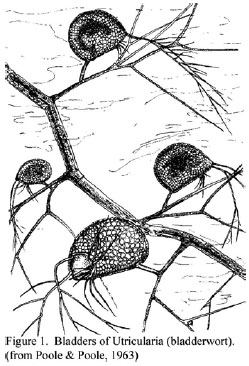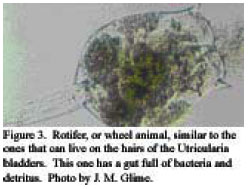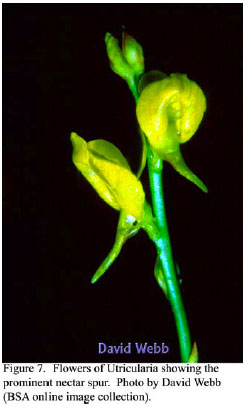 TRAP TYPE: Suction Trap
TRAP TYPE: Suction Trap
Currently 220 listed species occupying temperate and tropical habitats throughout the world--the most diverse and widespread genus of carnivorous plants.
Utricularia (bladderwort, Figure 2), a plant named for its tiny bladders, or utricles. Unlike the other carnivorous plants discussed here, Utricularia often lives in open water, but again where the nutrient concentration is relatively low. One common habitat is in the nutrient-poor bog lakes. In the open water, it supplements its nutrients by trapping insects in a bladder that is like a suction bulb (Figure 1, Figure 4, and Figure 5). Tiny hairlike projections at the opening of the bladder are sensitive to the motion of passing organisms like Daphnia (water fleas). When they are stimulated, these hairs cause the flattened bladder to suddenly inflate, sucking in water and the passing animal and closing a trap door after it.

If you ever remove a bladderwort plant from the water, you may be surprised to find audible crackling noises as the bladders get triggered shut by the motion and removal from water. Experiments indicate that growth will decrease by as much as one half if the bladders are removed. Lollar and coworkers (1971) fed labeled Crustacea (ostracods) to Utricularia and showed that radiophosphorus uptake was greater in plants with bladders than in plants without bladders, indicating that prey phosphorus is absorbed by the plant.
Those hair-like structures at the opening provide a nice habitat for a group of tiny rotifers, or wheel nanimals (Figure 3). These miniature organisms have two circles of cilia at their upper end, and they rotate these cilia in such a way that it looks kike two wheels spinning toward each other. The result is that the rotifer is able to grab small particles and organisms nearby and direct them toward its mouth. By sitting near the mouth of the bladder, they can take advantage of the current when the bladder closes and grab food particles from the inflow water. You may have noticed that many aquatic plants have leaves that are finely divided. Utricularia is no exception. These finely divided leaves greatly increase the surface area of the leaves.

And if you are a plant and live in the water, this is a big help. You are in need of CO2 for photosynthesis and of nutrients for growth. But both are scarce in water. In the atmosphere, CO2 is only ~0.03% of the air we (and plants) breathe. It is hard enough for land plants to get enough CO2 for photosynthesis. But in the water, this gas is even harder to get. Little of it dissolves in the water, and in the summer, when aquatic plants are actively growing, the water is warm and the gas easily escapes from the water to the atmosphere. Having lots of surface area relative to the leaf internal tissue permits the plant plant to take maximum advantage of the very small amount of CO2 that is in the water. And, that added surface area helps the plant obtain nutrients also. Unlike its terrestrial relatives that obtain their nutrients with their roots, these plants typically float and have no rooted connections to the soil. They must get their nutrients through their leaf surfaces like their cohabitants, the algae. Thus, these finely divided leaves create more surface area through which to obtain these nutrients.

Now, where does an unrooted aquatic plant go in winter? Many, like this bladderwort, form special bud-like structures called turions. These turions are really just dense masses of plant with nearly formed leaves, but in which the stem has not elongated. They differ from typical buds like the ones on trees because their leaves are much further developed. Furthermore, they have no bud scales or other protective outer tissues. They are, however, very densely formed into a sphere and packed with starch in their tissues. This makes them heavy and they sink to the bottom of the pond or lake. There they remain dormant during the winter. But take one of these and put it in a warm aquarium with some mud to provide nutrients. To your surprise, you are likely to find plants covering the entire aquarium in just 24 hours!

All it takes is elongation of the stem, and this is relatively simple as it requires mostly water to elongate the cells. So does this mean it doesn't need flowers and seeds? Well, producing only turions keeps making more plants like the parents, and it means being stuck in the same lake or pond nearly forever. Those bulky turions don't disperse well. So, yes, they do produce flowers, and these flowers are specially designed to be sure they get pollen from a different flower, thus permitting genes to mix and get lots of new combinations. They do this by the special structure of the flowers. Note in Figure 7 that the flowers have a large nectar spur. This spur, as its name implies, contains a nectar reward for its pollinators, the bees.

The face of the flower (Figure 8) attracts the bee with its bright yellow color. Once the bee lands, its weight pulls the lower petal down somewhat, opening the flower like a mouth. Just inside this mouth is the 2-parted stigma awaiting the delivery of pollen. If the bee has already visited other flowers, it most likely has pollen on its back and some of this will adhere to the open stigma as the bee enters the flower seeking the nectar in the long spur at the back. Then the flower does a very "smart" thing. That 2-parted stigma slowly moves its two parts together and closes! No, it doesn't trap the bee, but it does trap the pollen that the bee has left behind.
This accomplishes two things. First, it makes sure that when the bee leaves the flower it cannot deposit the flower's own pollen on the stigma, and the bee is sure to brush the anthers further inside the flower as it rummages down the throat to get the nectar. But the second advantage is that now the pollen has a moist, protected chamber in which to germinate and grow, making its pollen tube. But what if the bee had no pollen, or delivered pollen from some unrelated plant? The stigma then reopens after several hours and is once more ready to receive the real thing. You can tell if a flower has been pollinated in the past few days by examining the stigma to see if it is closed.

Ca. 200 Listed Species
U. purpureocaerulea A. St. Hil & Girard (1838) | U.albiflora R. Br. (1810) | U. albocaerulea Dalz. (1851) | U. alpina Jacq. (1760) | U. antennifera P. Taylor (1988) | U .appendiculata E .A. Bruce (1934) | U. arcuata Wight (1849) | U.arenaria A. DC. (1844) | U. arnhemica P. Taylor (1986) | U. asplundii P. Taylor (1975) | U. aurea Lour. (1790) | U. aureomaculata Steyerm. (1953) | U. australis R. Br. (1810) | U. beaugleholei Gassin (1993) | U. benjaminiana Oliv. (1860) | U. benthamii P. Taylor (1986) | U. bifida L. (1953) | U. biloba R. Br. (1810) | U. biovularioides P. Taylor (1986) | U. bisquamata Schrank (1824) | U. blanchetii A. DC. (1844) | U. bosminifera Ostenfeld (1906) | U. brachiata Oliv. (1859) | U. bracteata Good. (1924) | U. bremii Heer (1830) | U. buntingiana P. Taylor (1975) | U. calycifida Benj. (1847) | U. campbelliana Oliv. (1887) | U. capilliflora F. Muell. (1890) | U. cecilii P. Taylor (1984) | U. cheiranthos P. Taylor (1986) | U. chiribiquetensis Fernandez-Perez (1964) | U. choristotheca P. Taylor (1986) | U. christopherie P. Taylor (1986) | U. chrysantha R. Br. (1810) | U. circumvoluta P. Taylor (1986) | U. cornuta Michx. (1803) | U. corynephora P. Taylor (1986) | U. costata P. Taylor (1986) | U. cucullata A. St. Hil. & Girard (1838) | U. delicatula Cheesema (1906) | U. determanii P. Taylor (1986) | U. dichotoma J. J. H. Labillardiére (1804) | U. dimorphanta Makino (1906) | U. dunlopii P. Taylor (1986) | U. dunstaniae F. E. Lloyd (1936) | U. erectiflora A. St. Hil. & Girard (1838) | U. fimbriata H. B. K. (1818) | U. fistulosa P. Taylor (1986) | U. flaccida A. DC. (1844) | U. floridana Nash (1896) | U. foliosa L. (1753) | U. forrestii P. Taylor (1986) | U. foveolata Edgew. (1847) | U. fulva F. Muell. (1858) | U. furcellata Oliv. (1859) | U. garettii P. Taylor (1986) | U. geminiloba Benj. (1847) | U. geminiscapa Benj. (1847) | U. geoffrayi Pellegr. (1920) | U. georgei P. Taylor (1986) | U. gibba Linnaeus (1753) | U. graminifolia Vahl (1804) | U. guyanensis A. DC. (1844) | U. hamiltonii F. E. Lloyd (1936) | U. helix P. Taylor (1986) | U. heterochroma Steyerm. (1953) | U. heterosepala Benj. (1847) | U. hintonii P. Taylor (1986) | U. hispida Lam. (1791) | U. holtzei F. Muell. (1893) | U. humboldtii R. Schomb. (1841) | U. huntii P. Taylor (1986) | U. hydrocarpa Vahl (1804) | U. inaequalis A. DC. (1844) | U. incisa Alain (1956) | U. inflata Walt. (1788) | U. intermedia Hayne (1800) | U. involvens Ridley (1895) | U. jackii John Parnell (2005) | U. jamesoniana Oliv. (1860) | U. juncea Vahl (1804) | U. kamienskii F. Muell. (1893) | U. kenneallyi P. Taylor (1986) | U. kimberleyensis C. A. Gardner (1930) | U. kumaonensis Oliv. (1859) | U. laciniata A. St. Hil. & Girard (1838) | U. lasiocaulis F. Muell. (1885) | U. lateriflora R. Br. (1810) | U. laxa A. St. Hil. & Girard (1838) | U. lazulina P. Taylor (1984) | U. leptoplectra F. Muell. (1885) | U. leptorhyncha Schwarz (1927) | U. letestui P. Taylor (1989) | U. limosa R. Br. (1810) | U. livida E. Meyer (1837) | U. longeciliata A. DC. (1844) | U. longifolia Gardn. (1842) | U. macrocheilos P. Taylor (1986) | U. macrorhiza Le Conte (1842) | U. mannii Oliv. (1865) | U. menziesii R. Br. (1810) | U. meyeri Pilger (1901) | U. microcalyx P. Taylor (1971) | U. micropetala Sm. (1819) | U. minor L. (1753) | U. minutissima Vahl (1804) | U. mirabilis P. Taylor (1986) | U. monanthos Hook. f. (1860) | U. moniliformis P. Taylor (1986) | U. muelleri Kam. (1894 | U. multicaulis Oliv. (1859) | U. multifida R.Br. (1810) | U. myriocista A. St. Hil. & Girard (1838) | U. nana A. St. Hil. & Girard (1838) | U. naviculata P. Taylor (1967) | U. nelumbifolia Gardn. (1852) | U. neottioides A. St. Hil. & Girard (1838) | U. nephrophylla Benj. (1847) | U. nigrescens Sylven (1909) | U. novae-zelandiae Hook. f. (1853) | U. ochroleuca Hartm. (1857) | U. odontosepala Stapf (1912) | U. odorata Pellegr. (1920) | U. oliveriana Steyerm. (1953) | U. parthenopipes P. Taylor (1986) | U. paulineae Lowrie (1998) | U. pentadactyla P. Taylor (1954) | U. peranomala P. Taylor (1986) | U. perversa P. Taylor (1986) | U. petersoniae P. Taylor (1986) | U. petertaylorii A. Lowrie (2002) | U. physoceras P. Taylor (1986) | U. pierrei Pellegr. (1920) | U. platensis Speg. (1899) | U. pobeguinii Pellegr. (1914) | U. poconensis E. Fromm-Trinta (1985) | U. podadena P. Taylor (1964) | U. polygaloides Edgew. (1847) | U. praelonga A. St. Hil. & Girard (1838) | U. praeterita P. Taylor(1883) | U. praetermissa P. Taylor (1976) | U. prehensilis E. Meyer (1837) | U. pubescens Sm. (1819) | U. pulchra P. Taylor (1977) | U. purpurea Walt. (1788) | U. pusilla Vahl (1804) | U. quelchii N. E. Br. (1901) | U. radiata Small (1903) | U. raynalii P. Taylor (1986) | U. recta P. Taylor (1986) | U. reniformis A. St. Hil. (1835) | U. reticulata Sm. (1805) | U. rhododactylos P.Taylor (1986) | U. rigida Benj. (1847) | U. salwinensis Hand-Maz. (1936) | U. sandersonii Oliv. (1865) | U. sandwithii P. Taylor (1967) | U. scandens Benj. (1847) | U. schultesii Fernandez-Perez (1964) | U. simplex R. Br. (1810) | U. simulans Pilger (1914) | U. singeriana F. Muell. (1891) | U. smithiana Wight (1849) | U. stanfieldii P. Taylor (1963) | U. steenisii P. Taylor (1986) | U. stellaris L.f. (1781) | U. steyermarkii P. Taylor (1967) | U. striatula Sm. (1819) | U. stygia Thor. (1988) | U. subramanyamii Janarthanam & Henry (1989) | U. subulata Linnaeus (1753) | U. tenella R.Br. (1810) | U. tenuissima Tutin (1934) | U .terrae-reginae P. Taylor (1986) | U. tetraloba P. Taylor (1963) | U. tricolor St.Hil. (1833) | U. tridactyla P. Taylor (1986) | U. tridentata Sylvén (1909) | U. triflora P. Taylor (1986) | U. triloba Benj. (1847) | U. troupinii P. Taylor (1971) | U. tubulata F. Muell. (1875) | U. uliginosa Vahl (1804) | U. uniflora R. BR. (1810) | U. unifolia Ruiz & Pav. (1797) | U. violacea R. Br. (1810) | U. vitellina Ridley (1923) | U. volubilis R. Br. (1810) | U. vulgaris L. (1753) | U. warburgii Goebel (1891) | U. warmingii Kam. (1894) | U. westonii P. Taylor (1986) | U. wightiana P. Taylor (1986)






 TRAP TYPE: Suction Trap
TRAP TYPE: Suction Trap



